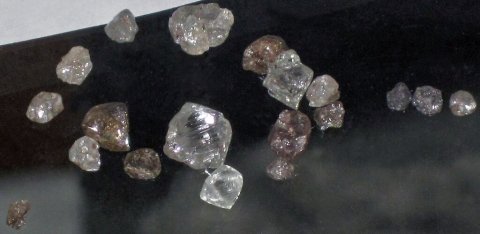De Beers’ half-yearly revenues highlighted the many challenges facing the diamond trade and the rough market. But in addition to the sharp declines suffered by the mining company, CEO Bruce Cleaver and chief financial officer Nimesh Patel were persevering in their reporting: This too will pass.
The executives recognized that the challenges came from within rather than from a collapse in consumer demand, even though they acknowledged the prevailing macroeconomic uncertainty. They found that there was an excess of polished stocks and a lack of liquidity in the midstream.
De Beers also pointed to the more conservative approach to stock management by retailers. Jewelers keep less goods in shops and take more goods on consignment. They buy less from diamond manufacturers, who in turn buy less from the miners.
These developments are not new; they have unfolded since the financial crisis of 2008. Their impact is now being felt through the excessive amount of rough that was put on the market in 2017 and 2018. The midstream is under pressure from both the mining and retail sectors, but especially from the mining sector.
More flexibility in rough market
Global rough production increased by 19%, or about 24.5 million carats, in 2017, according to Kimberley Process data. That was the year when three new mines were put into operation: Gahcho Kué, owned by De Beers and Mountain Province; the Stornoway Renard mine; and Firestone’s Liqhobong-operation.
Their timing was unfortunate given the weak market – especially for Stornoway, Firestone and Mountain Province, which each have only one diamond producing activity. For its part, De Beers has been making short-term profits over the last two years by selling as many diamonds as possible – with minimal adjustments to the rough prices – at a time when stocks in the midstream were increasing and the prices of polished diamonds were falling.
Now, De Beers is trying to position itself as a market savior through Cleaver and Patel’s messaging and the “flexibility” the company showed in July, when it allowed sightholders to postpone large parts of their purchases until later.
But this flexibility is simply necessary to control the damage caused by the recent excessive supply policy. It is also worth noting that the miner kept rough prices stable in the face of July, which rated at only $250 million after sightholders ‘approved’ De Beers’ offer for larger deferrals, i.e. buyers refused to accept the goods.
History repeats itself
We have seen this pattern before, including De Beers’ assurance that sales of rough will return as inventories in the midstream segment decline and demand improves around the end of the year period. It is true, the market is cyclical. However, these short-term expectations do not solve the medium-term profitability problem of the midstream.
The industry, led by De Beers, has in the past addressed the excess of the midstream by closing gaps, knowing that more will soon appear. Think of this quote from De Beers’ 2015 profit figures, the last time rough sales were so low:
“The weaker than expected consumer demand in 2015 has led retailers to reduce their demand for polished diamonds from the midstream manufacturers. The build-up of polished stocks in the middle segment put pressure on polished diamond prices and reduced the willingness of the mid-market to purchase additional rough diamonds. This was exacerbated by a tighter funding environment.”
Does that sound familiar? It is worth remembering what led to this difficult market environment.
The build-up of polished stock came when, in anticipation of further growth in China, manufacturers sent large quantities of goods to the Gemological Institute of America (GIA) to certify them in 2014. The GIA was not well-equipped for those volumes at the time and large quantities of diamonds remained stuck in the GIA’s laboratories. These goods were eventually launched in the first half of 2015, while China’s economic growth slowed and the government’s anti-corruption campaign curbed luxury purchases. The US dollar also strengthened against global currencies, putting further pressure on the diamond trade.
De Beers then gave sightholders the “flexibility” to postpone goods from the last sights of the year and deplete their excess polished stocks. De Beers’ turnover fell to an unprecedented $70 million in November 2015, while the company kept prices stable.
And then the cycle started again.
Demand driven rough market
In the three and a half years since then, the industry has experienced a rebound in rough production, even more caution on the part of the banks, notable fraud by members of the trade, Indian demonetization, a trade war that has slowed down the growth of the Chinese economy, and a strengthening of the dollar. Meanwhile, polished prices have continued to fall and the industry’s profit margins have been tightened.
To break the cycle, rough prices must fall, and the supply of the major miners – De Beers and Alrosa – must be less rigid in the long run.
Trade must stop being controlled from the supply side – or the leaders in the rough market, as the case may be. It must stop being dependent on the contract system, in which De Beers’ sightholders and the members of the Alrosa Alliance pay a premium for the promise of a consistent offer, but are also obliged to buy goods at unsustainable prices.
For too long, this system has proved unprofitable. It is time for the rough sector to focus more on auctions or tenders, where the market sets prices and manufacturers can buy what they need. To secure the profitable future of the diamond trade (and De Beers) in the long run, demand must be the driving force behind the rough market.







